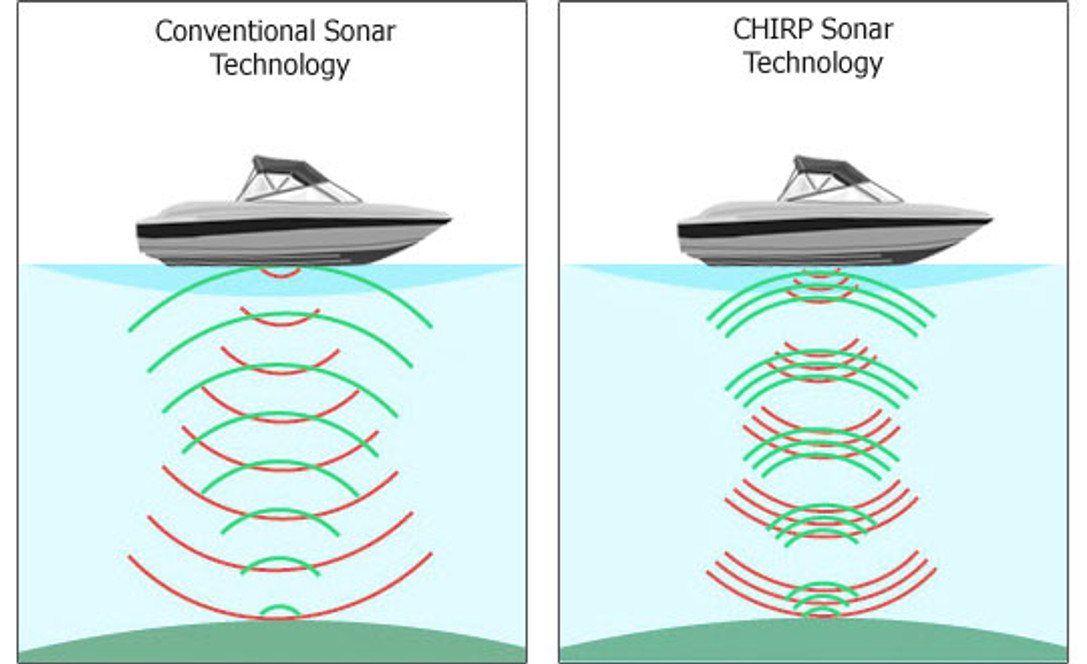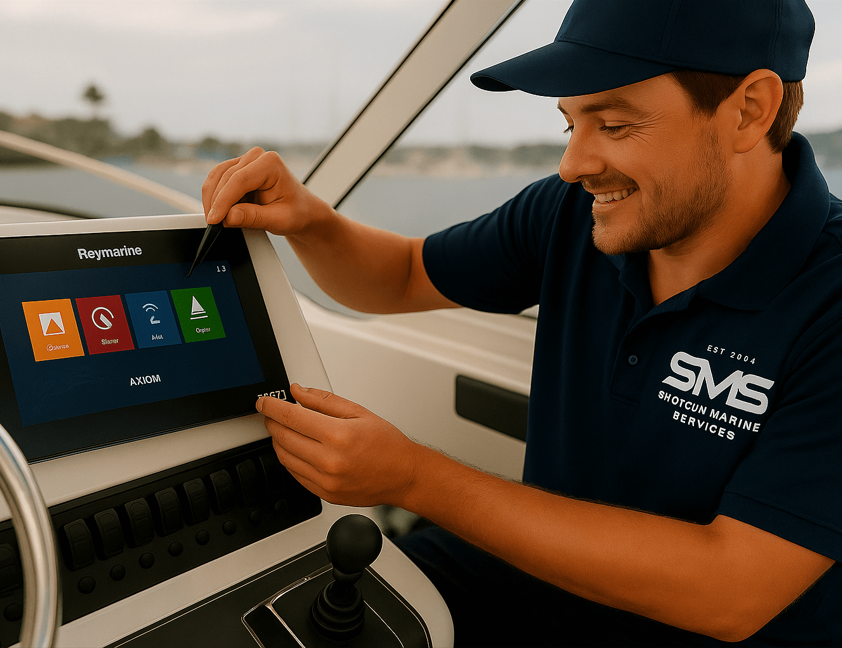What is CHIRP Sonar?
CHIRP Sonar resolves picture quality far better than the normal Sonar we’ve been used to historically.
Lots of guys still uses sonars with just the one single-frequency, or dual-frequency or perhaps maybe triple-frequency transducers. These have proven to serve anglers well for more than thirty years. However you’ve in all probability you have most likely heard on the marine electronics grapevine about these new technologies like CHIRP Sonar. Below I will explain as clear as possible what you should know about CHIRP, and what it will do to boost your fishing and water travels.
Traditional fixed-frequency Sonar
Traditional Sonar transmits a robust ping, or pulse of energy into the water column at a selected frequency, then “listens” for the echoes to come back. The unit’s software system then processes this data to form the image of bottom structure and fish that you just see on the display’s screen. This sort of “tone burst” energy pulse is also high in power, however it's terribly short in period. This limits the full quantity of energy that may be transmitted into the water column below the vessel.
Different frequencies reveal totally different levels of detail. As an example, a high-frequency 200kHz pulse provides great detail, however can’t penetrate the extreme depth. A low-frequency 50 kHz pulse penetrates deeper however shows far less detail. This can be why tradional used sonars currently use a minimum of a dual-frequency or maybe triple-frequency electrical device to produce a decent combination of depth and detail.
CHIRP Sonar with a range of ascending frequency.
CHIRP (Compressed High-Intensity Radiated Pulse) may be a game-changing technology that has been employed by the military for many years in each radar and Sonar. CHIRP technology began filtering all the way down to sports fishing and social boating sonar back in 2009.
Traditional tone burst frequency vs CHIRP frequency

CHIRP fish finders transmit an extended pulse than original Sonar focusing on putting energy into the water column, with a real broadband frequency ranging up to 117kHz.
Instead of pinging one frequency like the traditional 2nd Sonar, CHIRP devices transmit a range of frequencies that sweep. With every pulse, the electrical device starts moving at an occasional frequency, this is then modulated upward to a high frequency over the period of the pulse (130 to 210kHz, for example).
Old traditional Sonar transmits around hundredth of the time, however CHIRP sonars transmit ascending pulses that are 10 times as long in period. They place dramatically a lot of energy into the water column, ten to fifty times more! - Despite the fact that CHIRP devices usually transmit at lower peak power than traditional fishfinders.
Pulse compression and pattern correlation
Using innovative digital pattern matching and signal process, (This is named pulse compression) CHIRP devices acquire and process a lot of data from every pulse, enabling them to appreciate new resolution and target definition.
The pulse compression method, employed in each radar and Sonar systems, converts an extended period frequency-coded pulse into a slim pulse of extremely inflated amplitude. A narrow pulse with high peak power will be related from an extended period pulse with low peak power, increasing the range resolution and up the ration of signal to noise relationship, giving the device larger ability to find targets from the noise in the background.
CHIRP improves bottom pursuit at higher speeds and deeperwater. It helps resolve individual targets—no spots, however instead crisp separation of adjacent objects. The result's a spectacular improvement within the image you see.
Which CHIRP frequencies?
Which CHIRP frequencies must you choose? The fundamentals are the same as traditional 2D sonar:
High CHIRP range 150-240 kHz is for freshwater mostly inlands being a suitable option for lure tracking & distinguishing sport fish and baitfish targets, or for targeting sport fish close to bottom structure. Best for depths but 600'
Medium CHIRP range 80-160 kHz displays a wider coverage space, scanning massive areas a lot of quickly, showing larger fish arches however providing less detail than high CHIRP for seeing smaller objects. Like high CHIRP, it’s best for depths under 600'
Low CHIRP below eighty kHz (80) commonly used in deep water - over 600', offering great clarity depth performance (up to ten,000') and marks targets in the least depths within the water column
Better quality CHIRP fishfinders allow you to see 2 CHIRP frequencies on screen promptly, thus you'll sweep a broad cone on the MF (med frequency) CHIRP band. Then, once you notice one thing that appears interesting, take a better look on the tighter-focused high CHIRP setting.
The arrival of “affordable CHIRP technology”
What are the prices? Are they really affordable? What are the variations and range of price?
When this technology initial turned up on the market, CHIRP may solely be found in costly Sonar modules with the price tag being upwards of a few thousand bucks. They were created for the serious pros or for offshore fishermen searching for the most recent technology, no matter value. Today, CHIRP fishfinders, either Sonarmodules or chartplotter/fishfinder combos, are obtainable in all price ranges.
Below are a number of the premium options found on mostly the more expensive offshore CHIRP Sonar modules:
Two completely independent CHIRP channels: Operate 2 separate transdcuers or alternatively, one transducer covering 2 CHIRP frequency ranges-High, med, low, and ultralow –Designed to suit your specific variety of fishing and therefore the species you target
Ability to customise frequencies: a standard fastened frequency mode permits you to manually modify frequencies (from 25kHz to 210kHz, uses the Garmin GSD™ twenty six CHIRP skilled Sonar Module, for example) for increased targeting of specific fish species
Lots of sending power: Adjustable from regarding three hundred RMS watts all the thanks to 3kW or 4kW, for extreme depth ranges
Compatibility with several transducers: These embody Airmar’s latest camera lens 25° CHIRP series
Part of the NMEA 2000 network: These modules work with high-end displays jointly as part of a network. A large, high-resolution lcd display is important to be able to see all of target details from the powerful CHIRP Sonar
Garmin Striker four includes a twin beam 77/200kHz CHIRP Sonar, a colour screen and GPS to mark your favourite fishing spots, priced relatively low. Includes the traditional flasher option!
Mid-priced CHIRP fishfinders usually contain one CHIRP channel, typically with a sending power of 500W or 600W. Scanning Sonar, increased with CHIRP technology, is commonly engineered into the unit and the compatible transducer you’ll see CHIRP, side-scan and down-scan Sonar, all on the one screen. For the everyday or coastal angler, these fishfinder/chartplotter combos have all the functions you will want or need. 2 versions are usually sold; a coastal model, with acceptable mid/high-frequency electrical device and coastal charts, or the Inland version with high-frequency transducer along with inland charts. The value is commonly proportional to the scale and ldc Screen resolution.
Affordable CHIRP sonars, for the majority of us, are designed for inland anglers, and are the latest on the market. With a variety of makes and models come with a standalone Fishfinder, Sonar with GPS (but while not charts), or a sonar/chartplotter which include charts/maps.
There are loads of Sonar variations, too. Raymarine’ s Dragonfly GPS/Chartplotters combine the cone like shape 170-230kHz CHIRP Sonar with a wide-beam 320-380kHz CHIRP scanning Sonar component. Lowrance Hook combos combine their 455/800kHz scanning Sonar with Low, Med, High CHIRP, focused on 50/83/200kHz frequencies.
Whatever you what to spend. CHIRP Sonar has opened a new world for fishing. There’s ne'er been a far better time to upgrade this new technology you will love it!
Shotgun Marine are Service Agents for Raymarine sonar module prodcut and price, Simrad Chirp Sonar product and prices, Furuno, Koden, Garmin Chirp Sonar Module for Sale and more. We don’t just sell the gear.. We fit the gear, we use the gear. For more price and product info on what is Chirp Technology - follow our links.



